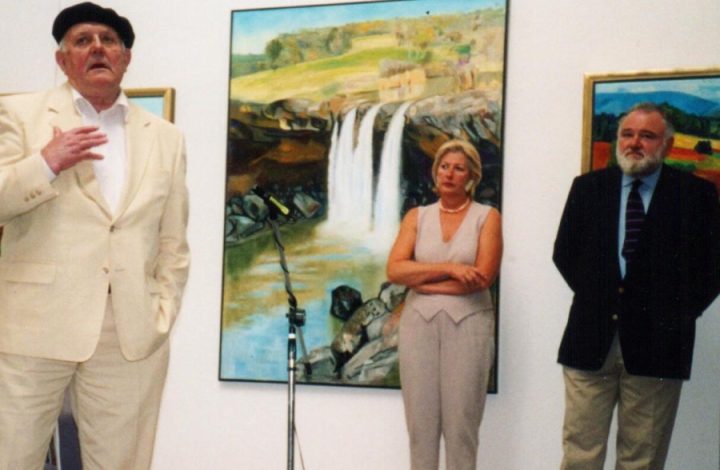
The art world is saddened by the death of John Olsen AO OBE (1928 – 2023) who died on Tuesday 11 April aged 95. He will long be celebrated as a creative visionary, particularly for his unique, poetic and often whimsical depictions of the Australian landscape in paintings and works on paper. Winner of the Wynne (1969, 1985) Sulman (1989) and Archibald (2005) art prizes, John enjoyed a successful career over 60 years, with his work represented in numerous major collections in Australia and internationally and he continued his artistic calling to the end.
Read further about his career on our Artist Biography page
We were fortunate to hear John share his thoughts on landscape painting at the opening of Jeff Makin’s exhibition at Lauraine Diggins Fine Art back in 2001 and share these with you now:
“It’s wonderful to be in Melbourne again. I seldom get to Melbourne these days. I’ve got lots of really strong and powerful memories for Melbourne and it really comes, interestingly enough, in connection with the Australian landscape.
Whilst I had predilictions, like going through an abstract period, when I was quite young and very immature basically, but my idea of abstraction was really that at the end there was going to be another kind of figuration that would be quite different from say the influence, the very strong influence of Picasso or even Matisse at the time.
I found myself in Melbourne and I was a friend of Clifton Pugh and Fred Williams and Albert Tucker, and we had this wonderful notion which really liberated me – that we would make the Australian landscape the open studio. It sort of figured like this, it wasn’t a case of just copying what was in front of us but somehow to gather an ethos, a kind of a mystical thing that emanates from the Australian landscape. This I can point back, and it is a very very interesting question that puzzles me enormously – for all forty thousand, fifty thousand, we don’t really know how long, the concentration in Aboriginal art is always centrally based on the landscape.
It really comes down to what I think is a very interesting line from T.S. Eliot – I am in the landscape and the landscape is in me. The thrust of a remark like that comes really from that it’s beyond trees, it’s beyond rocks, it belongs perhaps say to the principle of yin and yang, as Chinese art or Japanese art would look at it.
And then the other thing that is an interesting factor, is the Australian landscape seems to reveal itself in its stronger manner when viewed slightly from the air. I think that that is really to do with the sheer vastness of it. I mean, anyone who’s flown over, when you’ve been in Europe for a period of time, and you’re lucky enough just in the very early morning and the sun is rising over Australia and you’re coming perhaps over Broome and you’re going to go perhaps over Lake Eyre if you’re lucky – it’s wonderful, wonderful.
It’s this kind of thing that I think that even though Australian’s pullulate on the edges, albeit called Brisbane, Sydney, Melbourne, Adelaide, etc., that somehow that the vastness of the continent lies like a huge unconscious collective mind.
This kind of thing as I’m describing it presents an entirely different way, a different feeling to any other landscape that I have experienced or previously known. I’ve flown over Siberia, only from the air of course, that’s an oxymoron if ever I heard one! It is that kind of thing, and I have noticed. I don’t really know whether it’s to do with global village philosophy or the internet or those kind of things, but there seems to be a great turning away from that great mass of the song of the earth.
Jeff is one of those people who have been doggedly passionate about this very subject for a long long period of time. In actual fact, the awkwardness reminds me something of those early Cezannes. That awkwardness that you see in Cezanne which was scorned at in the early part of his career by Monet and Pissaro but they had a faith in him – why is it stumbling like this. It was to do with, to introduce a new ethic of structure into the French landscape. Looking at this, – where’s that lovely picture, yes it’s a lovely lovely picture and I happen to know where it is painted, and the implication and the definition of edge in it is very very strong. I have a notion that this is a turning point in Jeff’s career – a new kind of strength in an art which if one is distinct in contemporary terms is pretty god awful. It’s the lonely path and he’s done that. It’s a lot of credit that he could stand the loneliness of the long silent song.
I do not know what I prefer: the beauty of inflection or the beauty of innuendo – the blackbird singing or the thought afterwards, Wallace Stevens. It is that form of reverberation, and I think that you can perhaps see what I am getting at. It’s not the trees, it’s not the leaves, it represents a total experience.”
John Olsen, 2001
